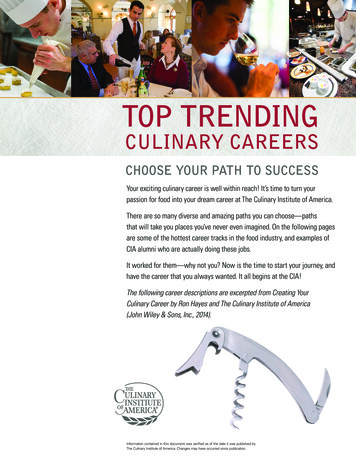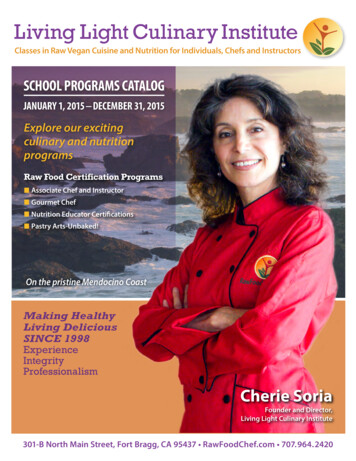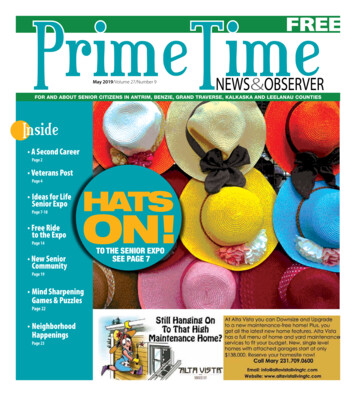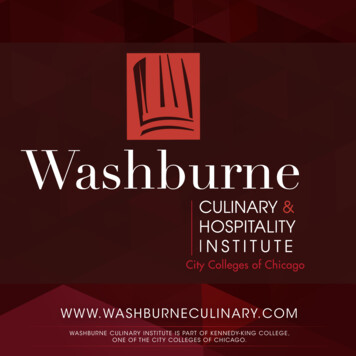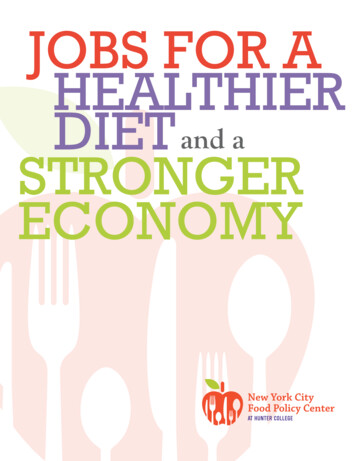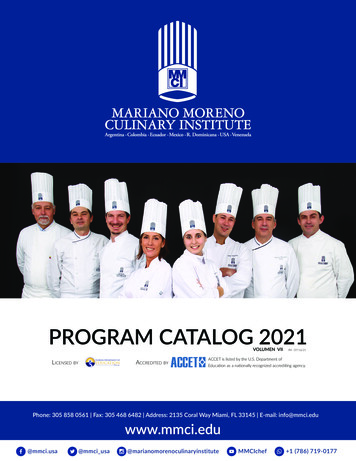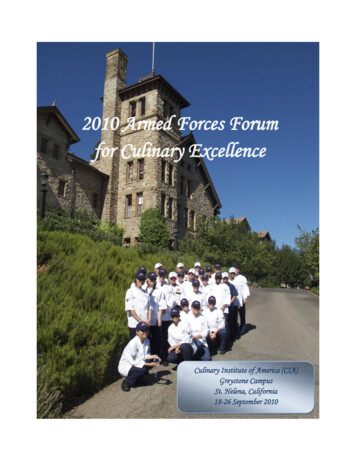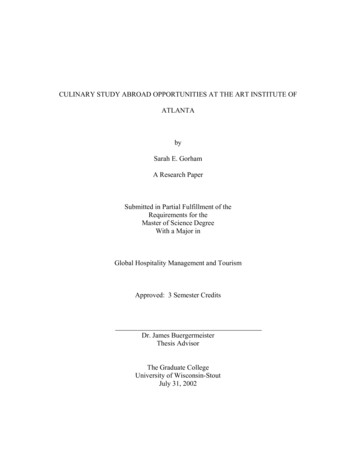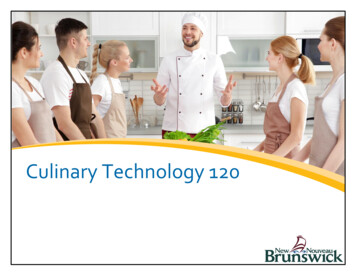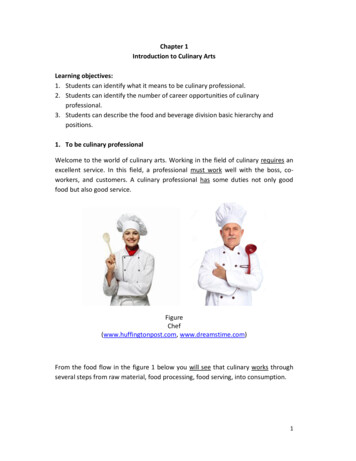
Transcription
Chapter 1Introduction to Culinary ArtsLearning objectives:1. Students can identify what it means to be culinary professional.2. Students can identify the number of career opportunities of culinaryprofessional.3. Students can describe the food and beverage division basic hierarchy andpositions.1. To be culinary professionalWelcome to the world of culinary arts. Working in the field of culinary requires anexcellent service. In this field, a professional must work well with the boss, coworkers, and customers. A culinary professional has some duties not only goodfood but also good service.FigureChef(www.huffingtonpost.com, www.dreamstime.com)From the food flow in the figure 1 below you will see that culinary works throughseveral steps from raw material, food processing, food serving, into consumption.1
FigureFood tailFoodProtection/FoodCode/ucm089302.htm)In Indonesia, someone could take vocational high school (SMK) to start the culinaryeducation then continue to university.2. Culinary careerWhat kind of career opportunity of culinary arts that may be of your choice?2
Figure 2. Culinary ry-careers/)There are a number of culinary careers that you can choose to be. Below are someoptions that common in the food service providers such as in hotel and restaurant(The American Culinary Foundation, 2006).a. Chef (Executive chef).Responsibilities: a head of the kitchen who handles all kitchen operationssuch as scheduling, developing menu, and food ordering. He/she supervisesall kitchen stations including food costs.b. Sous chef (Assistant chef)Responsibilities: assists the executive chef to manage and control thestation chefs. He/she should answer to the executive chef.c. Station chef.Responsibilities: supervises all the kitchen stations including:1) Sauté chef (saucier) in handling all sautéed items and their sauces.2) Fish chef (poissonier) in handling fish items and their sauces.3) Roast chef (rotisseur) in handling roasted foods.4) Grill cheff (grillardin) in handling all grilled foods.5) Vegetable chef (entremetier) in handling hot appetizer, soups,vegetables, and pastas.3
6) Roundsman (tournant) or swing cook in supporting all divisions in thekitchen.7) Expediter or announcer (aboyeur) in handling the order from the diningroom to the suitable station in the kitchen, checking the food on theplate, and delivering the food to the customer.8) Communard in preparing the food to the staff during the shift break.9) Commis (apprentice or stager) in working under chef assistance to learnthe stations.The figure below shows the illustration of culinary career path as a chef.FigureSample Culinary Career Path(http://www.reynolds.edu/get started/programs/business/culinary and hospitality/industry.aspx)3. Food and beverage division basic structure.Below is a general food and beverage staffs in the restaurant hotel.4
Figure 3. Food and beverage division structureIn the food and beverage division, the positions are more complex because thedivision manages variety of departments including room service, beverage,steward, restaurant, and catering.Nowadays, culinary professional has some more job opportunities and challengesto be:a.b.c.d.e.f.g.h.i.Food and beverage managerRestaurant consultants and design specialistSalespeople for food supply, kitchen equipment, and new products.TeachersFood writers and criticsFood stylist and photographersResearch and development kitchenCake designerEntrepreneurs5
Grammar FocusSubject-Verb AgreementAll parts of a sentence must match. If the subject is singular, then the verb must besingular, and the pronoun should be singular too. Similarly, if the subject is plural,the verb should be plural, and any pronoun should be plural too(http://www.stlcc.edu, 2005). A good arrangement that match all parts of asentence can be seen in the following examples:Me and my classmate - - - - - - - - - - - -prepare - - - - - - - - - our recipes for practicetomorrow.(plural subject & antecedent)(plural verb)(plural pronoun)The teacher - - - - - - - - - - - - - - - - - - - - -reminds - - - - - - - - - - - - -his students to beready for the exam.(singular subject & antecedent)(singular verb)(singular pronoun)The details of subject-verb agreement are as /599/1/)When the subject of a sentence is composed of two or more nouns or pronounsconnected by and, use a plural verb.She and her friends are at the fair.When two or more singular nouns or pronouns are connected by or or nor, use asingular verb.The book or the pen is in the drawer.When a compound subject contains both a singular and a plural noun or pronounjoined by or or nor, the verb should agree with the part of the subject that isnearer/closer to the verb.The boy or his friends run every day.His friends or the boy runs every day.6
Doesn't is a contraction of does not and should be used only with a singularsubject. Don't is a contraction of do not and should be used only with a pluralsubject. The exception to this rule appears in the case of the first person andsecond person pronouns I and you. With these pronouns, the contraction don'tshould be used.He doesn't like it.They don't like it.Do not be misled by a phrase that comes between the subject and the verb. Theverb agrees with the subject, not with a noun or pronoun in the phrase.One of the boxes is openThe people who listen to that music are few.The team captain, as well as his players, is anxious.The book, including all the chapters in the first section, is boring.The woman with all the dogs walks down my street.The words each, each one, either, neither, everyone, everybody, anybody,anyone, nobody, somebody, someone, and no one are singular and require asingular verb.Each of these hot dogs is juicy.Everybody knows Mr. Jones.Either is correct.Nouns such as civics, mathematics, dollars, measles, and news require singularverbs.The news is on at six.Note: the word dollars is a special case. When talking about an amount ofmoney, it requires a singular verb, but when referring to the dollars themselves, aplural verb is required.Five dollars is a lot of money.Dollars are often used instead of rubles in Russia.7
Nouns such as scissors, tweezers, trousers, and shears require plural verbs.(There are two parts to these things.)These scissors are dull.Those trousers are made of wool.In sentences beginning with "there is" or "there are," the subject follows theverb. Since "there" is not the subject, the verb agrees with what follows.There are many questions.There is a question.Collective nouns are words that imply more than one person but that areconsidered singular and take a singular verb, such as group, team,committee, class, and family.The team runs during practice.The committee decides how to proceed.The family has a long history.My family has never been able to agree.The crew is preparing to dock the ship.Expressions such as with, together with, including, accompanied by, inaddition to, or as well do not change the number of the subject. If thesubject is singular, the verb is singular too.The President, accompanied by his wife, is traveling to India.All of the books, including yours, are in that box.Verb for single – plural pronounSingle pronoun V1s(he, she, it)Plural pronoun V1(I, you, they, we)8
Exercises:1. Choose the best answer suited to the sentence.a. Your chances of winning the lottery in New York State (is/are) less thanbeing struck by lighteningb. People who do win the lottery, though they may have the goodintention to invest, occasionally (end/ends) up becoming impoverishedbecause they give all their money to charity.c. When students, no matter how much energy they have, (stay/stays) upall night, they are not alert in the morning.d. I used to fly to Buffalo every summer and live in Florida every winter, butnow I (live/lives) here permanently.e. After class, Anisa (run/runs) to her car and drives to work.f. Once in a while, Patty (go/goes) shopping in an Indian grocery store andcooks chicken.g. Why don't we (visit/visits) the park on the weekend and bring somefriends with us?h. If it (rain/rains) today, I will not need to go to his house.i. A lot of people (consider/considers) John to be very quietj. There (is/are) too much crime in this world.k. Either answer (is, are) acceptable.l. Every one of those books (is, are) fiction.m. Nobody (know, knows) the trouble I've seen.n. (Is, Are) the news on at five or six?o. Mathematics (is, are) John's favorite subject, while Civics (is, are)Andrea's favorite subject.p. Eight dollars (is, are) the price of a movie these days.q. (Is, Are) the tweezers in this drawer?r. Your pants (is, are) at the cleaner's.s. There (was, were) fifteen candies in that bag. Now there (is, are) onlyone left!t. The committee (debates, debate) these questions carefully.u. The committee (leads, lead) very different lives in private.v. The Prime Minister, together with his wife, (greets, greet) the presscordially.w. All of the CDs, even the scratched one, (is, are) in this rcises/agreement sv /13/34)9
2. Discuss jobs and careera. What do you do? / What is your job?I am a I work as a I work in a b. Tell about your job/the job you hope to doMy/the job involves -ingYou need to be/have The best thing about being a is that .c. What is your career dream in culinary arts?I am hoping to be a(n) I am studying to be a(n) d. What motivates you to be your career dream?3. List any new words in this chapter. Discuss with your friends.New worddefinition10
Chapter 2Work settingLearning objectives:1. Students can identify the type of restaurant2. Students can identify the food and beverage area function1. Restaurant typesDifferent types of restaurant determine activities that vary from one to another.a. Fine dining restaurant. This type of restaurant offers a complete menu fromappetizer, main course, and dessert. Typically, customers come to finedining restaurant to celebrate the special occasion such as wedding,birthday, and business meeting. The customers attend by invitation andwear formal dress. The food is usually expensive and well-decorated. Thewaitress provides a full service for each table.FigureFine dining e-dining-restaurants.php)b. Casual dining restaurant. The restaurant offers a more informal and relaxingatmosphere than in a fine dining restaurant. The price is lower than in a finedining. The restaurant has a more attractive design of menu and décor.11
FigureCasual dining restaurant(http://tastealbany.com/restaurant/)c. Quick service restaurant/fast foodThe restaurant offers a ready to serve meal. The food is usually precook orpartially cooked so it can be finished quickly once the customer has theorder. Typically, customers stand a line to order the food, pay, bring thefood by themselves, then leave the restaurant once they finished.FigureFast food s/Commercial/Fast Food Restaurants/)12
d. Family restaurantMenus in the family restaurants offer variety of selection (Powers &Barrows, 2006) to accommodate all family members from children toelderly.FigureFamily restaurant(http://www.garveyspub.com/)e. Ethnic restaurantEthnic restaurant offers a cuisine and theme (Powers & Barrows, 2006)which deliver a certain place, destination, or ethnic tribe such as Javanese,Italy, Thai, and Chinese.FigureEthnic restaurant(self documentation)13
f. Theme restaurantTheme restaurant provides a certain idea to express fun, fantasy, glamour,or romantic activity. This can be theme of movie, good old days, travel,ecology, sport (Walker & Lundberg, 2001). It also includes robot theme,extreme activity, and nature theme.FigureRobot theme waiters.html)2. Food and beverage areaIn the food and beverage providers, there are three areas that define differenttype of workers and responsibilities.a. Front of the houseThis area is a service area where the waitress serves the guests. Itincludes the area of dining room, cashier, toilet/rest room, andpraying room (if available).b. Back of the houseBack of the house prepares food production. This area consists ofthe kitchen and storage area, including cooking equipment. The backof the house area must ensure that the kitchen staffs can work freely14
and comfortably. It must provide a good kitchen layout to make thestaffs work efficiently.FigureKitchen 20restaurant.ppt)c. The officeThe office has functions as administrative coordination andaccounting in the operation (Powers & Barrows, 2006).Grammar Focus:Preposition of place.Prepositions of place are used to show the position or location of one thing toanother. It answers the question "Where?"15
Preposition of place:In front ofNext to/besideBehindOnAtInAboveUnderIn the corner tions-of-place.htm)Exercise:1. Write your own sentence describing the restaurant layout below using thepreposition of place words.16
2. List any new words in this chapter. Discuss with your friends.New worddefinition3. Read the comic below then retell to your class with your own sentences.(http://languagelog.ldc.upenn.edu/nll/?p 4590)17
Chapter 3Cooking Utensils and EquipmentLearning objectives:1. Students can identify and describe each cooking equipment in the kitchen andits function2. Students can identify and describe each cooking utensil in the kitchen1. Cooking Equipmentsa. Primary Equipments1) Ranges or stovesStove is the most prominent equipment in the kitchen. It may appear inthe open top or flat top as the figure below.It either fired by gas or electricity.FigureRanges / Stoves (Brown, 2004)2) OvensThe conventional oven usually placed in the bottom part of the stovehowever it can be also separated unit alone. It relies on hot air forheating the food. Oven primarily used for baking and roasting but notlimited to use for braising, poaching, and simmering (Brown, 2004).18
FigureOvens (Brown, 2004)3) Microwave ovenA microwave oven uses less energy than a conventional oven (Holladay,2014) unless you cook for a large quantity of food. In a large entity ofmeals, cooking with conventional oven will save more energy andproduce better taste too.FigureMicrowave oven (Holladay, 2014)19
4) RefrigeratorRefrigerator plays important role to prevent bacterial infections fromfood by freezing it. Most refrigerators have special place for placingmeats, fruits, and vegetables.FigureRefrigerators (Brown, 2004)5) DishwasherDishwasher is mechanical equipment to clean dishes and kitchenutensils. Dishwasher for food service providers usually requiresseparated room. However some types of dishwasher are built-in to beintegrated with the kitchen cabinet. It is connected to water supply andelectrical source to produce hot water.20
shwasher.clipart.htm)b. Auxiliary Equipments1) GriddlesGriddle is used to add-on the stove/range. It has a larger and flatsurface. Griddle is ideal for cooking eggs, hamburgers, pancakes, andtoast. It contains of a drip cup to save draining oil comes from the fryingprocess. To prepare the cooking process, simply smearing the surfacewith oil then quick heating (Brown, 2004). To retain the function,griddles are not washed by soap and water but scraped and wiped withgrease mop and polished with a soft cloth.FigureGriddle (Brown, 2004)21
2) Tilting skilletsThis equipment is commonly found in large food service providers. Itcan be used for fry anything with a wide range of temperature set.FigureTilting skillet (Brown, 2004)3) Broilers and GrillsBroil is heating the food with the heat above the food while grill’s heatis under the food. The heat energy comes from gas, electricity, woods,or charcoal.FigureBroiler and tEquipment/Broilers-Grills)22
4) SteamersA proper steaming will maintain the flavor, texture, color, and nutrientsof cooked fish and vegetables. Steamers can be either in the cabinet orkettle form. Steam jacket kettle is used for more liquid type of foodsuch as soups and stews. Steam captured inside the enclosed space toproduce moist heat.Safety is the most concern on using steamers. It should be away fromthe body contact, periodically checked to ensure the food inside thesteamer does not over-cooked or run out of water, and never beopened until the steam process is done.FigureSteamers (Brown, 2004)5) Deep-fat FryersDeep-fat fryers do the same thing as boiling. The difference is thatboiling use water while deep fry requires fat oil so that it can reachhigher temperature than boiling process. This equipment usually hastemperature control. The food is placed in the big strainer then put inthe hot frying oil. When food floats on the oil, it considered as cooked.The food then strained to get the oil drained.23
FigureDeep-fat Fryers (Brown, 2004)6) WoksA wok is a large bowl-shaped pan for cooking Chinese food. Cookingtime in a wok lasts for 5-10 minutes however the preparation takeslonger time as the food needs to be cut into uniform small pieces. Thefood then is stirred rapidly, the heat turned into lower temperature,the pan covered until the process completed.FigureWok (Brown, 2004)24
7) CrockeryElectric slow cookers or crockery are suitable for moist heat cooking ofmeat and legumes (such as beans, peas, clover, peanuts). The processof cooking using crockery is long and slow, with heat controller thatrequires little rect/home-electrical/slowcookers/cat3374426.cat)8) Cutting equipmentCutting equipment involves sharp blades and electric motor therefore acareful well attention should be taken in operating the machine.25
FigureFood Chopper and Grinder (Brown, 2004)Slicer and food chopper are usually used for meat, cheese, vegetables,fruit, and bread to achieve a uniform product and less time spent onfood preparation.The equipment must be wholly sanitized after use and plugged offwhen the machine is not in use to maintain a good machine conditionand to avoid safety hazard (Brown, 2004).9) MixersMixers are suitable for mixing the ingredients in a larger quantity thanblender and food processor. Mixer typically has attachments of wirewhip, flat beater for general mixing, and dough hook for heavy doughmixing. Blender produces more refined mixing food especiallyvegetable and liquid ingredients such as milk. Food processor is more26
adaptable equipment that allows cutting, chopping, grinding,shredding, and kneading the food and dough.FigureBlender and Food Processor (Brown, 2004)FigureTabletop mixer (Brown, 2004)27
10) Coffee makersCoffee makers are used to process the coffee daily. The electric pot inthe coffee makers is connected to a hot water source.FigureCoffee Makers (Brown, 2004)c. Pots and PansPots and pans are distinguished by their size, shape, and handle. It madefrom a variety of materials:- Aluminum, copper, and stainless steel to produce good conductor forheat.- Non stick coating to produce non stick pans. It reduces the amount offat however its surface is easily scratched therefore plastic, rubber, andwooden spatula are recommended.28
--Cast iron to retain high temperature for a longer period of time.However they are heavy, heat slowly, and not easy to clean. Acidicfoods such as tomato sauce absorb iron while being cooked so it addsextra iron to the food.Glass pan to be used either in the cold or hot equipment. However theusage is not allowed in the food service as it easily to be broken. Unlikethe cast iron, glass pan do not react with the food being cooked.FigureVarious Pots and Pans (Brown, 2004)29
FigurePot materials (Brown, 2004)2. Cooking Utensilsa. Mixing BowlsThe mixing bowl usually made form glass, pottery or ceramic, orstainless steel. With a various type of sizes it allows the ingredientsmixing using hand.30
FigureMixing nce-6-qt-mixingbowl.html)b. KnivesKnife is considered as the most important tools in food preparation.There are different type of knives, along with its function and way ofcaring them.31
FigureAnatomy of a es-basic-cuts/)32
FigureKnives (Brown, 2004)French knife is one of the largest and most useful for all purpose forcutting meats, mincing, dicing, and chopping various types of foods.Utility knife is used to do lighter tasks such as cutting vegetables orfruits, or carving meats.Paring knife is useful for more delicate tasks but requires closecontrol such as trimming vegetables, fruits, and small pieces of meat.Boning knife separates meat from bone, disjoints poultry, and dicingraw meats.Slicing knife forms as a long and flexible to slice into thin part ofmeat, poultry, and cake.33
FigureTypes of ves-basic-cuts/)34
c. Preparation utensils1) SpatulasSpatula is used to lift up the food from pans or other kind ofsurfaces, spread frostings, butter, and other soft foods (Brown,2004). The stainless steel spatula helps turn meats and otherfoods while reStainless Steel inless-steel-bbqspatula.html)35
2) Cutting boardFigureCutting Boards/6448/subcat.html)3) TongsTong is used to turn meat or other kind of foods while broilingand frying, lift vegetables, serve foods and ice /categories/departments/cooking/20647/)36
4) Wooden ForksForks help turn th emeat while cooking or to hold the foods whilebeing cut or g/categories/departments/cooking/20647/)5) WhisksWhisk helps mixing and smooting usually eggs, flour, butter,margarine, cream, sauces, and so og/categories/departments/cooking/20647/)37
6) MoldsMolds come with variety of shapes and sizes to be used informing gelatin and dessert’s size.FigureMolds7) BrushersBrushers helps spreading melted butter or thin mixtures such asicing, removing grease from soup, sauce, and stock (Brown,2004).FigurePastry es/departments/cooking/20647/)38
8) Wooden SpoonsSpoons help stirring mixing creaming, tossing, folding, lift foods,and log/categories/departments/cooking/20647/)9) SkimmersSkimmer is used to remove scum and grease from the top ofstocks and gravies, and to lift the food out of hot liquid like g/categories/departments/cooking/20647/)39
10) StrainersStrainer helps separating solid from liquid. Strainers come withvariety of sizes, shapes, and .com/small-strainer-5)11) ColanderColander is used to drained foods and rinse vegetables in sa.com/search?q colander)40
12) Chonical StrainerChonical Strainer helps to strain liquids from solid when makingsoups, gravies and puree foods.FigureChonical Strainer(http://www.matferbourgeatusa.com/search?q china cap)13) Rolling pinRolling pin is used to roll out pastry, rolls, and cookies dough(Brwon, 2004).FigureRolling Pins(http://www.matferbourgeatusa.com/search?q rolling pin)41
14) ScraperScraper is used to scrap the rolling dough, cut the dough intosmaller pieces, or to clean the stuck grilling items on the -6-inch-Overall-Length-Made-inthe-USA)15) Pastry bagsPastry bags help making the shape of pastries and decorations.With a variety of tubes or tips, it creates different shapes of softfoods.FigurePastry for-writing-2)42
16) PeelerPeeler helps peeling the fruits skin effieciently.FigureFruit and vegetable s/departments/cooking/20647/)17) GraterGrater helps grating foods like cheese and fruits into fine log/categories/departments/cooking/20647/)43
18) Meat tenderizerMeat tenderizer is used to create smoothing meat texture in thefood peparation using hand power so that it easier to chew anddigest.FigureMeat ories/departments/cooking/20647/)19) FunnelsFunnels are usually made from stainless steel, aluminum, glass, orplastic. It helps channeling liquid or fine substances into containers witha small opening to avoid spillage.FigurePlastic es/departments/cooking/20647/)44
d. Measuring utensilsRecipes contain certain amount of ingredients needed to make thedesired foods. To have similar product result across time and tomaintain consistency when the food is cooked by any chef, precisemeasurement of the amount of ingredients is required. Below aresome important measuring tools for solid and liquid foods.FigureScales and Measuring Utensils (Brown, 2004)45
Sharpen a kitchen knifeKitchen knives are the basic tool in the kitchen. Since its function is important, itshould be well treated. A good kitchen knife will effectively reducing foodpreparation time as it slice through ingredients quickly and safely. To do so, kitchenknives can be sharpened at home using a few basic fe).1. Gather the necessary materials including:a. a double-sided (coarse and fine grit) synthetic sharpening stone.b. a sharpening steel, which is typically sold in the form of a lightlygrooved, magnetized iron rod.Both of these materials can be found at the local hardware store.2. Sharpen the knife blade using the stone.Hold the knife with the fingers of one hand fanning across the length ofthe blade while placing it flat against, and perpendicular to, the coarseside of the sharpening stone.b. Raise the blade approximately 20 degrees off of the face of the stone,with the edge of the blade facing away from you.c. Grind the blade onto the stone in a counterclockwise motion, from tip tobolster. Use consistent pressure and grind until a burr forms on theunderside of the blade.d. Flip the blade over so it faces toward you and repeat grinding in the samemanner until the edge forms another burr.a.46
3. Polish the edge of the blade using the fine grit side of the sharpeningstone.Position the blade in the same manner as above.b. Grind the blade in a counterclockwise manner. Do the same for thealternating sides every 4 strokes.a.4. Steel the blade to remove debris and irregularities that have formed as aresult of grinding.Hold the steel perpendicular to your work surface, placing the metaledge on top of a cutting board for stability.b. Place the blade against the rod. The end of the blade closest to theknife's handle should touch the top of the steel. The tip of the bladeshould point skyward and the blade itself should be angledapproximately 20 degrees to the rod.a.5. Move the blade against the steel in a downward, sweeping motion.Pull the knife toward you as it glides down the steel. Position the knifeso the blade's middle touches the steel's middle and the blade's tiptouches the bottom of the rod.b. Use gentle, consistent pressure. Then, turn the knife over and repeat.c. Eight to 10 alternate passes should effectively restore the knife's edge.a.47
Grammar FocusParallel StructureSentence elements that are alike in function should also be alike inconstruction. These elements should be in the same grammatical form so that theyare parallel (Benner, 2006). Parallelism provides the balance between two or moresimilar words, phrases or clauses. It prevents awkwardness, promotes clarity yenglishpages.com/site php Parallelism is used with elements joined by linking words.Here is the example:The teacher not only wants his students to keep quiet but also to do the task .The teacher wants his students not only to keep quiet but also to do the task .Here are some examples of parallel elements48
These elements below, on the other hand, are not parallelThere are some ways to employ parallelism in the sentence.1. With elements joined by coordinating conjunctions, especially and,but, and or.Examples of parallel wordsExamples of parallel phrases49
Examples of parallel clausesThe examples below show how to repair faulty parallelism.Example No. 1Example No. 2Exercise:Find the incorrect words (faulty parallelism) then change it into correct form.1. What I said or my actions upset everyone in the room.2. She suggested that I write a memoir and to send it to a good publisher.50
3. The instructor advised me to use the rearview mirror often, and I shouldobserve the speed limit.4. People are paying more now for health insurance but to get less coverage.5. Doing strenuous exercise and poor nutrition habits can lead to illness.6. We put the pictures and what our itinerary was into the album.7. Many young people like to skateboard and watching the techniques of otherskateboarders.8. Joe wants to buy a vest that has buttons or closing with a zipper.9. Her ideas are usually sound and of importance.10. Good sense and being thoughtful are two valuable assets.2. Use parallel structure wit
A culinary professional has some duties not only good food but also good service. Figure Chef (www.huffingtonpost.com, www.dreamstime.com) From the food flow in the figure 1 below you will see that culinary works through several steps from raw material, food


